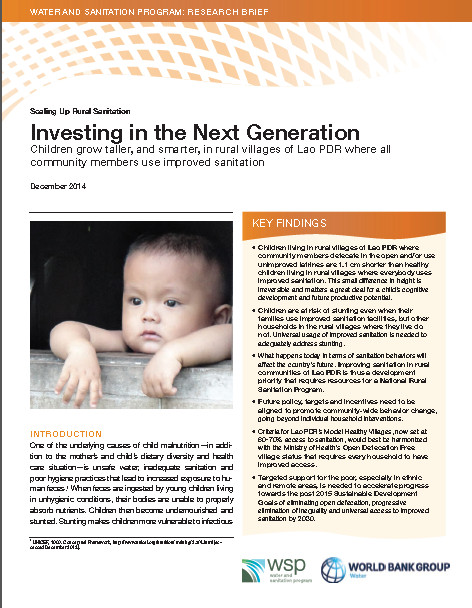Investing in the Next Generation: Children Grow Taller, and Smarter, in Rural Villages of Lao PDR Where All Community Members Use Improved Sanitation
 |
note Dec 2014 ; 8 pages
Ed. WSP - Washington
Téléchargeable sous format: PdF
Téléchargeable chez l'éditeur
Page de présentation d'un éditeur
Abstract:
One of the underlying causes of child malnutrition—in addition to the mother’s and child’s dietary diversity and health care situation—is unsafe water, inadequate sanitation and poor hygiene practices that lead to increased exposure to human feces. While urban sanitation access in Lao PDR is 90%, 50% of rural households are still practicing open defecation and/or using unimproved sanitation as of 2012. Remote and poor rural areas are even worse off and only 13% of the poorest households are using improved sanitation. Inequalities along ethnic groups are persistent, with 74% of Lao-Tai families using improved sanitation and only 30% of Mon Khmer, 46% of Hmong-Mien and 30% of Chinese-Tibetan. During the last decade child malnutrition has improved very marginally and almost 49% of rural children were stunted in 2011 [27% of urban children]. Stunting has a permanent impact on the life of a child. It does not only affect the child’s height, but also her/his cognitive abilities. Stunted children are likely to become less productive adults, and be less able to contribute to their country’s growth and prosperity.
Mots clefs: |
ATPC Assainissement Total Piloté par la Communauté (CI) (DT) (OP) (ope) , enfant (CI) (DT) (OP) (ope) , santé (CI) (DT) (OP) (ope) |
Pays concerné: |
Editeur/Diffuseur: |
|
WSP
-
Water and Sanitation Program - Washington - Etats Unis |
En cas de lien brisé, nous le mentionner à communication@pseau.org